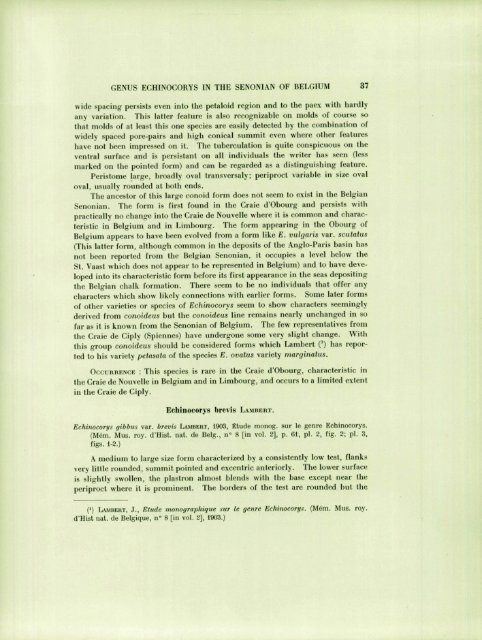ECIIINOID GENUS ECHINOCOIÎYS
ECIIINOID GENUS ECHINOCOIÎYS
ECIIINOID GENUS ECHINOCOIÎYS
You also want an ePaper? Increase the reach of your titles
YUMPU automatically turns print PDFs into web optimized ePapers that Google loves.
<strong>GENUS</strong> ECHINOCORYS IN THE SENONIAN OF BELGIUM 37<br />
wide spacing persists even into the petaloid region and to the paex with hardly<br />
any variation. This latter feature is also recognizable on molds of course so<br />
I hat molds of at least this one species are easily detected by the combination of<br />
widely spaced pore-pairs and high conical summit even where other features<br />
have not been impressed on it. The tuberculation is quite conspicuous on the<br />
ventral surface and is persistant on all individuals the writer has seen (less<br />
marked on the pointed form) and can be regarded as a distinguishing feature.<br />
Peristome large, broadly oval transversaly; periproet variable in size oval<br />
oval, usually rounded at both ends.<br />
The ancestor of this large conoid form does not seem to exist in the Belgian<br />
Senonian. The form is first found in the Craie d'Obourg and persists with<br />
practically no change into the Craie de Nouvelle where it is common and characteristic<br />
in Belgium and in Limbourg. The form appearing in the Obourg of<br />
Belgium appears to have been evolved from a form like E. vulgaris var. scutatus<br />
(This latter form, although common in the deposits of the Anglo-Paris basin has<br />
not been reported from the Belgian Senonian, it occupies a level below the<br />
St. Vaast which does not appear to be represented in Belgium) and to have developed<br />
into its characteristic form before its first appearance in the seas depositing<br />
the Belgian chalk formation. There seem to be no individuals that offer any<br />
characters which show likely connections with earlier forms. Some later forms<br />
of other varieties or species of Echinocorys seem to show characters seemingly<br />
derived from conoideus but the conoideus line remains nearly unchanged in so<br />
far as it is known from the Senonian of Belgium. The few representatives from<br />
the Craie de Ciply (Spiennes) have undergone some very slight change. With<br />
this group conoideus should be considered forms which Lambert O has reported<br />
to his variety petasata of the species E. ovalus variety marginatus.<br />
OCCURRENCE : This species is rare in the Craie d'Obourg, characteristic in<br />
the Craie de Nouvelle in Belgium and in Limbourg, and occurs to a limited extent<br />
in the Craie de Ciply.<br />
Echinocorys brevis<br />
LAMBERT.<br />
Echinocorys gibbus var. brevis LAMBERT, 1903, Étude monog. sur le genre Echinocorys.<br />
(Mém. Mus. roy. d'Hist. nat. de Belg., n° 8 [in vol. 2], p. 61, pi. 2, fig. 2; pi. 3,<br />
figs. 1-2.)<br />
A medium to large size form characterized by a consistently low test, flanks<br />
very little rounded, summit pointed and excentric anteriorly.<br />
The lower surface<br />
is slightly swollen, the plastron almost blends with the base except near the<br />
periproet where it is prominent.<br />
The borders of the test are rounded but the<br />
(>) LAMBERT, J., Etude monographique sur le genre Echinocorys. (Mém. Mus. roy.<br />
d'Hist nat. de Belgique, n° 8 [in vol. 2], 1903.)

















